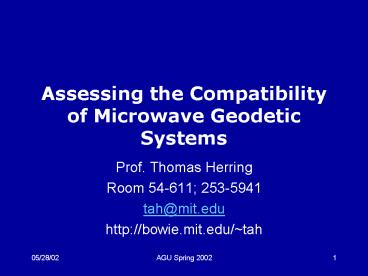Assessing the Compatibility of Microwave Geodetic Systems - PowerPoint PPT Presentation
Title:
Assessing the Compatibility of Microwave Geodetic Systems
Description:
Zoom of NyAlison (Sep 30-Oct 2) 05/28/02. AGU Spring 2002. 17. Clock comparisons ... Zoom area for Wettzell. 05/28/02. AGU Spring 2002. 21. Conclusions ... – PowerPoint PPT presentation
Number of Views:19
Avg rating:3.0/5.0
Title: Assessing the Compatibility of Microwave Geodetic Systems
1
Assessing the Compatibility of Microwave Geodetic
Systems
- Prof. Thomas Herring
- Room 54-611 253-5941
- tah_at_mit.edu
- http//bowie.mit.edu/tah
2
Overview
- Examine the compatibility of VLBI and GPS systems
by comparing clock and atmospheric delay
estimates from the two systems - Data Analyzed
- End of the CONT96 VLBI experiments
- Common stations Fairbanks, Wettzell, Kokee,
Nyales20. No GPS at NRAO station. - Additional 20 global stations used in GPS
analysis
3
VLBI and GPS Network
4
Analysis Technique
- VLBI CALCSOLVK Kalman filter
- Clock process noise consistent with 10-14 Alan
standard deviation at 1000 seconds Quadratic
terms removed apriori. - Atmospheric process noise Derived from
delay-rate variance Typical random walk values
10 mm/sqrt(hr) variations of factor of three
about this value - Constant zenith delay based on station height and
zero water vapor
5
Analysis Technique
- GPS GAMIT program
- Clocks estimated epoch-by-epoch relative to
Fairbanks/Gilcreek clock - Phase clocks aligned with clocks from
pseudo-range estimates - Atmospheric delay estimated with piece-wise
linear function with nodes every 2-hours.
Stochastic noise 20 mm/sqrt(hr) - Constant apriori zenith delay.
6
Some effects that might be expectedClock effects
- GPS is controlled by 10.23 MHz oscillators
- On the Earths surface these oscillators are set
to 10.23x(1-4.4647x10-10) MHz (39,000 ns/day rate
difference) - This offset accounts for the change in potential
and average velocity once the satellite is
launched. - The first GPS satellites had a switch to turn
this effect on. They were launched with
Newtonian clocks
7
Corrections terms
- Propagation path curvature due to Earths
potential (a few centimeters) - Clock effects due to changing potential
- For e0.02 effect is 47 ns (14 m)
8
Relativistic Effects (SA off)
50 ns15m
9
Comparisons
- Atmospheric delays
- Easiest comparison because apriori zenith delay
chosen as constant and the same apriori used for
VLBI and GPS - Clocks
- Clocks are more difficult to compare because
- No absolute standard for either system (show
clocks relative to Fairbanks/Gilcreek) - VLBI has different quadratic removed each day.
Clocks relative to ensemble - GPS also referred to Fairbanks. Only linear
trend removed each day.
10
Fairbanks Atmospheric delays
11
Wettzell Atmosphere
12
Zoom of Wettzell (Sep 19-20)
13
Zoom Wettzell (Sept 30-Oct 2)
14
KOKEE Atmosphere
15
NyAlison Atmosphere
16
Zoom of NyAlison (Sep 30-Oct 2)
17
Clock comparisons
- Clock comparison are complicated by the removal
of trends from VLBI results (can be corrected but
currently time-consuming). - Absolute offsets can not be compared because of
VLBI group delay ambiguities the GPS alignment
of phase and range unknown delays in VLBI and
GPS electronics - Examine difference of Wettzell and Fairbanks
clocks
18
Wettzell-Fairbanks comparison
19
Wettzell-Fairbanks with VLBI quadratic removed
20
Zoom area for Wettzell
21
Conclusions
- Initial study of comparison between VLBI and GPS
clock parameters and atmospheric delay estimates. - Initial results indicate that clocks are
comparable quality (no smoothing in GPS) - Next steps
- Accounting for clock rates and accelerations
applied to VLBI - More consistency in mapping functions and
gradients - Effects of model changes in GPS (antenna phase
centers) on clock comparisons - Time dependent process for GPS atmospheres
(validation using VLBI data) - Possible use of GPS atmospheres and clocks in the
analysis of VLBI?































